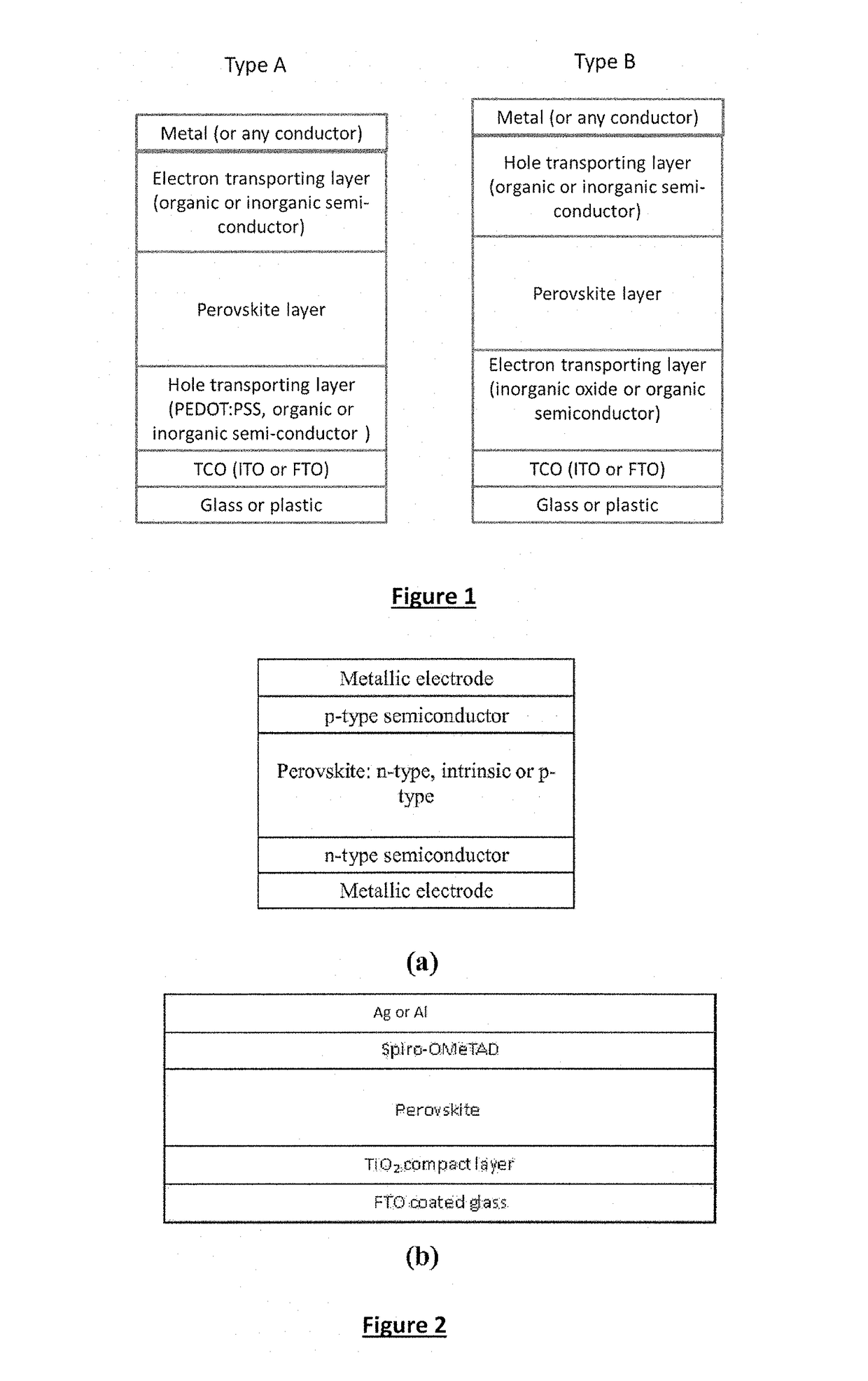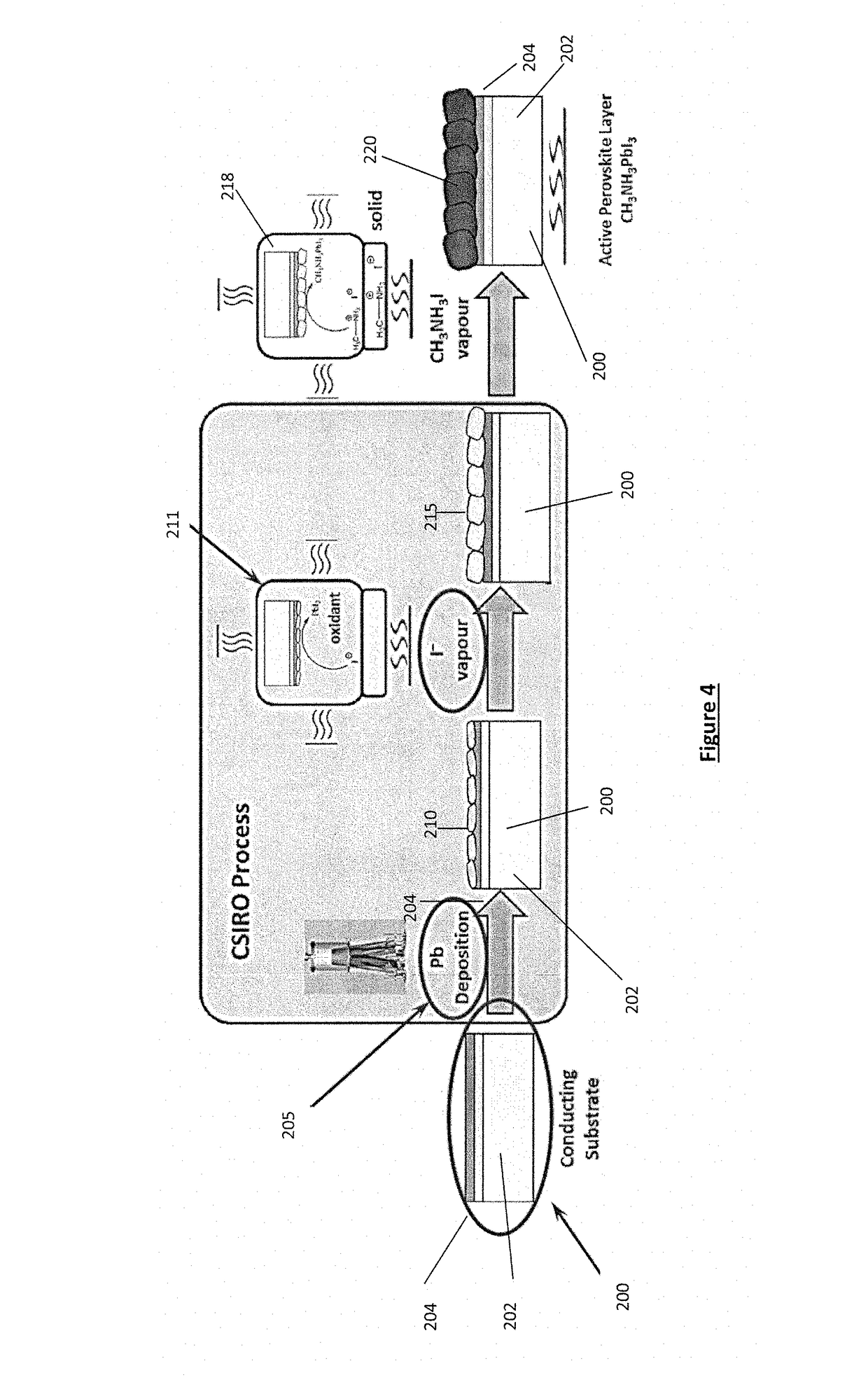Process of forming a photoactive layer of an optoelectronic device
a technology of optoelectronic devices and photoactive layers, which is applied in the direction of electrophoretic coatings, electrolytic capacitors, liquid/solution decomposition chemical coatings, etc., can solve the problems of difficult large-scale production of these types of pv cells, difficult process of applying photoactive layers,
- Summary
- Abstract
- Description
- Claims
- Application Information
AI Technical Summary
Benefits of technology
Problems solved by technology
Method used
Image
Examples
example 1
emical Deposition of Pb Thin Film Seed Layer for Planar Perovskite Solar Cells
[0263]In this example, a thin metallic Pb seed layer is electrochemically deposited on an n-type compact blocking layer, in this case TiO2, as a precursor for a perovskite solar cell. The deposited Pb seed layer is then chemically converted to the photoactive perovskite material.
[0264]It should be appreciated that whist demonstrated for planar perovskite solar cells, the method and techniques exemplified can equally be applied to non-planar perovskite solar cells configurations for example the inclusion of a mesoscopic thin-film of nanoparticles for example TiO2, Al2O3, ZrO2 or the like.
1.1 Electrochemical Deposition of Pb
[0265]The electrochemical deposition equipment included the following:
[0266]An electrolyte consisting of a 0.01 mol / L solution of Pb(NO3)2 as Pb source and 0.1 mol / L KNO3 as inert conducting electrolyte (also known as supporting electrolyte.
[0267]A working electrode (that where the reacti...
example 2
vaporation of Thin Pb Film as Perovskite Seed Layer for Planar Perovskite Solar Cells
[0275]In the following two examples (2.1 and 2.2), a thin metallic Pb seed layer is formed by thermal evaporation of Pb and condensation onto an n-type compact blocking layer (in this example either ZnO or TiO2) as a precursor for a perovskite solar cell. The seed layer once deposited is then chemically converted to the photoactive perovskite material.
2.1 ZnO Blocking Layer on Indium-Doped Tin Oxide (ITO) Substrate Embodiment
2.1.1 Substrate Preparation
[0276]The ITO substrate was cleaned by successive sonication treatments in detergent (Hellmanex, 1% in milli-W water), pure milli-Q water and isopropanol.
[0277]ZnO blocking layer was applied by spin casting a suspension of ZnO nanoparticles in 1-butanol onto the cleaned ITO substrate. The film was annealed at 100° C. After annealing, the ZnO film was treated by plasma treatment for 1 hour. This was necessary for film stability.
2.1.2 Pb Seed Layer Depos...
example 4 — embodiment
Example 4—Embodiment of Evaporated Pb Seed Layer
[0294]In the following example, a thin metallic Pb seed layer was formed by thermal evaporation of Pb and condensation onto an n-type compact blocking layer (in this example either ZnO or TiO2) as a precursor for a perovskite solar cell. The seed layer once deposited is then chemically converted using I2 vapour treatment and subsequent exposure to CH3NH3I vapour in a 2-step treatment to form a photoactive perovskite material following the same method outline in Example 2.
[0295]FIG. 13 depicts a calibration plot of evaporated Pb seed thickness against the final perovskite active film thickness as a function of deposited Pb thickness.
[0296]FIG. 14 shows an AFM topography of the layers of a perovskite active film formed from the thermally-evaporated Pb seed layer. This demonstrates that the thin-film maintains the morphology of the FTO substrate from Pb seed layer, to PbI2 and the final CH3NH3PbI3, substantially matching the surface rough...
PUM
| Property | Measurement | Unit |
|---|---|---|
| thickness | aaaaa | aaaaa |
| thickness | aaaaa | aaaaa |
| deposition rate | aaaaa | aaaaa |
Abstract
Description
Claims
Application Information
 Login to View More
Login to View More - R&D
- Intellectual Property
- Life Sciences
- Materials
- Tech Scout
- Unparalleled Data Quality
- Higher Quality Content
- 60% Fewer Hallucinations
Browse by: Latest US Patents, China's latest patents, Technical Efficacy Thesaurus, Application Domain, Technology Topic, Popular Technical Reports.
© 2025 PatSnap. All rights reserved.Legal|Privacy policy|Modern Slavery Act Transparency Statement|Sitemap|About US| Contact US: help@patsnap.com



